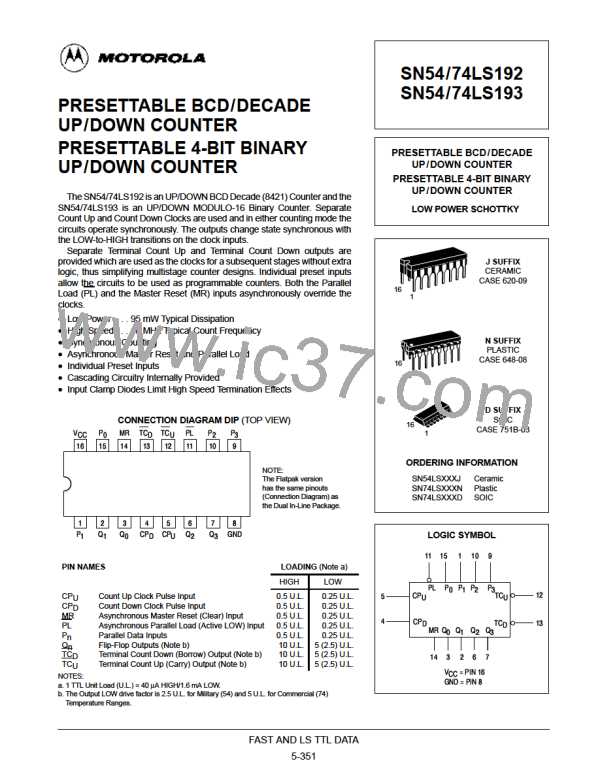SN54/74LS192 • SN54/74LS193
FUNCTIONAL DESCRIPTION
The LS192 and LS193 are Asynchronously Presettable
Decade and 4-Bit Binary Synchronous UP/DOWN (Revers-
able) Counters. The operating modes of the LS192 decade
counter and the LS193 binary counter are identical, with the
only difference being the count sequences as noted in the
State Diagrams. Each circuit contains four master/slave
flip-flops, with internal gating and steering logic to provide
master reset, individual preset, count up and count down
operations.
Each flip-flop contains JK feedback from slave to master
such that a LOW-to-HIGH transition on its T input causes the
slave, and thus the Q output to change state. Synchronous
switching, as opposed to ripple counting, is achieved by
driving the steering gates of all stages from a common Count
Up line and a common Count Down line, thereby causing all
state changes to be initiated simultaneously. A LOW-to-HIGH
transition on the Count Up input will advance the count by one;
a similar transition on the Count Down input will decrease the
count by one. While counting with one clock input, the other
shouldbe held HIGH. Otherwise, the circuit will either count by
twos or not at all, depending on the state of the first flip-flop,
which cannot toggle as long as either Clock input is LOW.
The Terminal Count Up (TC ) and Terminal Count Down
U
(TC ) outputs are normally HIGH. When a circuit has reached
D
the maximum count state (9 for the LS192, 15 for the LS193),
the next HIGH-to-LOW transition of the Count Up Clock will
cause TC to go LOW. TC will stay LOW until CP goes
U
U
U
HIGH again, thus effectively repeating the Count Up Clock,
but delayed by two gate delays. Similarly, the TC output will
D
go LOW when the circuit is in the zero state and the Count
Down Clock goes LOW. Since the TC outputs repeat the clock
waveforms, they can be used as the clock input signals to the
next higher order circuit in a multistage counter.
Each circuit has an asynchronous parallel load capability
permitting the counter to be preset. When the Parallel Load
(PL) and the Master Reset (MR) inputs are LOW, information
present on the Parallel Data inputs (P , P ) is loaded into the
0
3
counter and appears on the outputs regardless of the
conditions of the clock inputs. A HIGH signal on the Master
Reset input will disable the preset gates, override both Clock
inputs, and latch each Q output in the LOW state. If one of the
Clock inputs is LOW during and after a reset or load operation,
the next LOW-to-HIGH transition of that Clock will be
interpreted as a legitimate signal and will be counted.
MODE SELECT TABLE
MR
PL
CP
CP
MODE
U
D
H
L
L
L
L
X
L
H
H
H
X
X
H
X
X
H
H
Reset (Asyn.)
Preset (Asyn.)
No Change
Count Up
H
Count Down
L = LOW Voltage Level
H = HIGH Voltage Level
X = Don’t Care
= LOW-to-HIGH Clock Transition
FAST AND LS TTL DATA
5-354

 MOTOROLA [ MOTOROLA ]
MOTOROLA [ MOTOROLA ]